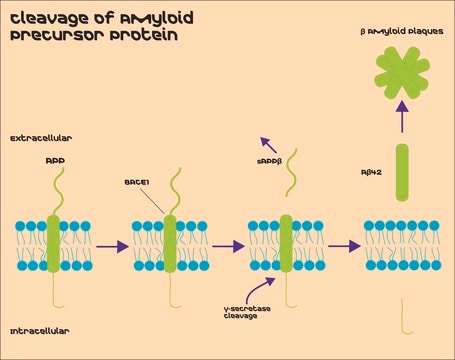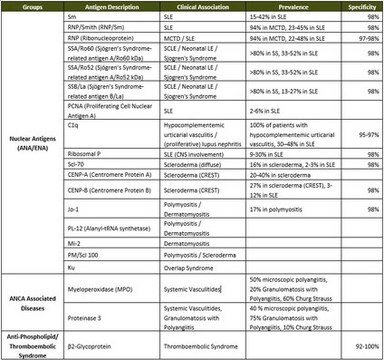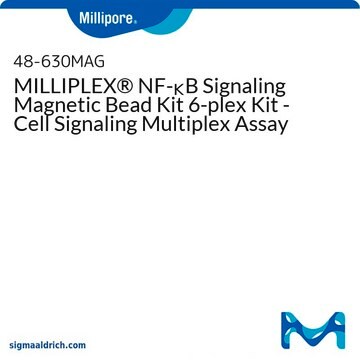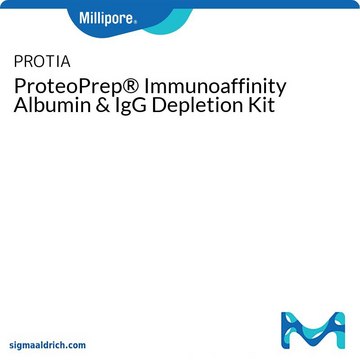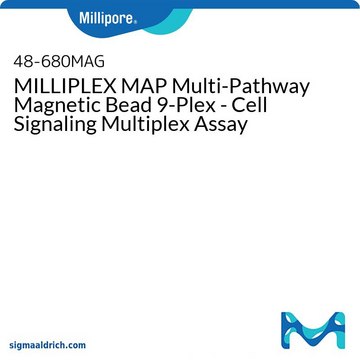48-684MAG
MILLIPLEX® Ras-Raf Oncoprotein Magnetic Bead Panel 6-Plex - Cell Signaling Multiplex Assay
Synonym(s):
Cell Signaling Assay
Sign Into View Organizational & Contract Pricing
All Photos(1)
About This Item
UNSPSC Code:
12161503
NACRES:
NA.47
Recommended Products
species reactivity
human
manufacturer/tradename
Milliplex®
technique(s)
multiplexing: suitable
detection method
fluorometric (Luminex® xMAP®)
storage temp.
2-8°C
General description
Ras proteins are GTPases encoded by three genes: HRAS, KRAS, and NRAS. The protein products of these genes exhibit a high degree of sequence identity and are regulated by a conserved mechanism: exchange of GDP for GTP switches the Ras protein into an active conformation. In its GTP-bound state, Ras has high affinity for its downstream effectors, including the Raf family of protein kinases (ARAF, BRAF, and CRAF/RAF1). Raf proteins, in turn, signal through MEK to activate the MAPK pathway. In healthy cells, Ras activation is a transient response to extracellular growth stimuli and is restricted by the rapid conversion of Ras-GTP back to Ras-GDP. However, the Ras-Raf-MEK pathway is often aberrantly activated in cancer. Mutations in the RAS genes are amongst the most frequently encountered oncogenic events, occurring in ~25% of human cancers, with mutations altering the 12th amino acid (glycine) being particularly prevalent. These driver mutations maintain Ras in a constitutively active, GTP-bound state. Additionally, certain cancers feature KRAS gene amplification, although the effects of gene amplification on protein expression are not yet well-characterized.The MILLIPLEX® MAP 6-plex Ras-Raf Oncoprotein Magnetic Bead Kit (Cat. No. 48-684MAG) is a premixed kit to be used for the simultaneous quantification of the following 6 protein analytes:pBRAF (Ser446)pCRAF (Ser338)pMEK1 (Ser217/Ser221)Ras (total)Mutant Ras protein, RasG12D*Mutant Ras protein, RasG12V**Detects H-Ras, N-Ras, and K-Ras protein
Specificity
Cross-reactivity between the antibodies and any of the other analytes in this panel is non-detectable or negligible.
Application
Intracellular Bead-Based Multiplex Assays using the Luminex technology enable the simultaneous relative quantitation of multiple phosphorylation and total pathway proteins in tissue and cell lysate samples. Compare Multiplexing results to those of Western blotting.An overnight (4°C) incubation is recommended for best results.This kit must be run using Assay Buffer 2 (provided).This assay requires 25 μL diluted cell lysate per well.The suggested working range of protein concentration for the assay is 1 to 25 μg of total protein/well (25 μL/well at 40 to 1,000 μg/mL).Analytes available:BRAF (Ser446);CRAF (Ser338);MEK1 (Ser217/Ser221);Ras (total);RasG12D;RasG12V
Features and Benefits
Configuration: Premixed
Packaging
96-well plate
Storage and Stability
Recommended storage for kit components is 2 - 8°C.
Legal Information
Luminex is a registered trademark of Luminex Corp
MILLIPLEX is a registered trademark of Merck KGaA, Darmstadt, Germany
xMAP is a registered trademark of Luminex Corp
Disclaimer
Unless otherwise stated in our catalog or other company documentation accompanying the product(s), our products are intended for research use only and are not to be used for any other purpose, which includes but is not limited to, unauthorized commercial uses, in vitro diagnostic uses, ex vivo or in vivo therapeutic uses or any type of consumption or application to humans or animals.
Signal Word
Danger
Hazard Statements
Precautionary Statements
Hazard Classifications
Acute Tox. 4 Oral - Aquatic Acute 1 - Aquatic Chronic 2 - Eye Dam. 1 - Skin Irrit. 2
Storage Class Code
10 - Combustible liquids
Certificates of Analysis (COA)
Search for Certificates of Analysis (COA) by entering the products Lot/Batch Number. Lot and Batch Numbers can be found on a product’s label following the words ‘Lot’ or ‘Batch’.
Already Own This Product?
Find documentation for the products that you have recently purchased in the Document Library.
Our team of scientists has experience in all areas of research including Life Science, Material Science, Chemical Synthesis, Chromatography, Analytical and many others.
Contact Technical Service
